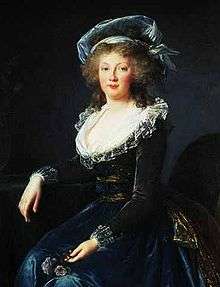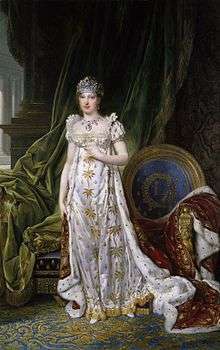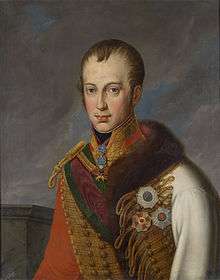Maria Theresa of Naples and Sicily
| Maria Theresa of Naples | |||||
|---|---|---|---|---|---|
 Maria Theresa in 1790 | |||||
| Holy Roman Empress German Queen | |||||
| Tenure | 1 March 1792 – 6 August 1806 | ||||
| Empress consort of Austria | |||||
| Tenure | 11 August 1804 – 2 March 1807 | ||||
| Born |
6 June 1772 Royal Palace, Naples | ||||
| Died |
13 April 1807 (aged 34) Hofburg Palace, Vienna, Austria | ||||
| Burial | Imperial Crypt, Vienna, Austria | ||||
| Spouse | Francis II, Holy Roman Emperor | ||||
| Issue Detail | |||||
| |||||
| House | Bourbon-Two Sicilies | ||||
| Father | Ferdinand I of the Two Sicilies | ||||
| Mother | Maria Carolina of Austria | ||||
| Religion | Roman Catholicism | ||||
Maria Theresa of Naples and Sicily (6 June 1772 – 13 April 1807) was the eldest daughter of Ferdinand IV & III of Naples and Sicily (later Ferdinand I of the Two Sicilies) (1751–1825) and his wife, Marie Caroline of Austria (1752–1814). She was the last Holy Roman Empress and the first Empress of Austria.
Biography
Born Maria Teresa, and named after her maternal grandmother Maria Theresa of Austria, she was the eldest of 17 children born to her parents, the King and Queen of Naples and Sicily. Her father was a son of Charles III of Spain and Princess Maria Amalia of Saxony. Through her mother she was a niece of Marie Antoinette; through her father she was a niece of Maria Luisa of Spain and Charles IV of Spain. She was her mother's favourite child from birth until she left the Neapolitan court to marry.
Her brothers included the future King Francis and Leopold, Prince of Salerno. Another, Carlo, Duke of Calabria died in 1778 aged 3 of smallpox.
Her sisters included Grand Duchess of Tuscany. Her younger sister Princess Maria Cristina, was the wife of the future Charles Felix of Sardinia as Queen of Sardinia. Maria Cristina's twin Princess Maria Cristina Amelia died in 1783 of smallpox. Another sister was the Queen of the French as the wife of Louis Philippe I and the youngest was the future Princess of Asturias.
Marriage

On 15 September 1790 she married her double first cousin Archduke Francis of Austria, who would later become Holy Roman Emperor Francis II, and then Emperor Francis I of Austria. The marriage is described as a happy one, despite differences in personality.
Maria Theresa was described as easy-going with a sensuous appearance. She loved masquerades and carnivals, and participated in every ball even while she was pregnant.
Hedwig Elizabeth Charlotte of Holstein-Gottorp described the view of Maria Theresa and the relationship between the couple in her famous diary during her visit to Vienna in 1798–99:
The Empress is reputed to be so jealous that she does not allow him to take part in social life or meet other women. Vicious tongues accuse her of being so passionate that she exhausts her consort and never leaves him alone even for a moment. Although the people of Vienna cannot deny that she is gifted, charitable and carries herself beautifully, she is disliked for her intolerance and for forcing the Emperor to live isolated from everyone. She is also accused of interesting herself in unimportant matters and socializing exclusively with her lady-companions. With them she spends her evenings singing, acting out comedies and being applauded.[1]
In February 1799, her seeming indifference to the revolution against her parents in Naples attracted some disfavour in Vienna.[2] Hedwig Elisabeth Charlotte also recounts a scene described to her by a foreigner, who bribed his way into the private park at Laxenburg and came to witness a scene between the couple:
"He saw the Emperor sitting on a bench, alone in his thoughts. Immediately, the Empress came to fetch him, and he exlaimed: "Can't you ever leave me alone, so that I may breathe for one moment? For God's sake, don't follow me around all the time."[3]
She did have some political influence, as she was interested in politics. She gave her husband advice and is believed to have been partially responsible for the dismissal of Johann Baptist Freiherr von Schloissnigg and Graf Franz Colloredo; she was also critical of Napoleon and encouraged her husband in the wars against him.
An important patron of Viennese music, she commissioned many compositions for official and private use. Joseph Haydn wrote his Te Deum for chorus and orchestra at her request. He also composed numerous masses to celebrate her reign. Her favourite composers included Paul Wranitzky and Joseph Leopold Eybler, a composer of sacred music.
Issue
Titles and styles
- 6 June 1772 -15 September 1790: Her Royal Highness Princess Maria Theresa of Naples and Sicily
- 15 September 1790 - 1 March 1792: Her Royal Highness Archduchess Francis of Austria
- 1 March 1792 - 11 August 1804: Her Imperial Majesty The Holy Roman Empress, German Queen, Queen of Hungary and Bohemia
- simplified: Her Imperial Majesty The Holy Roman Empress
- 11 August 1804 - 6 August 1806: Her Imperial and Royal Apostolic Majesty The Holy Roman Empress, Empress of Austria, German Queen, Queen of Hungary and Bohemia
- 6 August 1806 - 13 April 1807: Her Imperial and Royal Apostolic Majesty The Empress of Austria, Queen of Hungary and Bohemia
Ancestry
References
- ↑ Charlottas, Hedvig Elisabeth (1927) [1797-1799]. af Klercker, Cecilia, ed. Hedvig Elisabeth Charlottas dagbok [The diary of Hedvig Elizabeth Charlotte] (in Swedish). VI 1797-1799. Translated by Cecilia af Klercker. Stockholm: P.A. Norstedt & Söners förlag. pp. 160–61. OCLC 14111333. (search for all versions on WorldCat)
- ↑ Charlottas, Hedvig Elisabeth (1927) [1797-1799]. af Klercker, Cecilia, ed. Hedvig Elisabeth Charlottas dagbok [The diary of Hedvig Elizabeth Charlotte] (in Swedish). VI 1797-1799. Translated by Cecilia af Klercker. Stockholm: P.A. Norstedt & Söners förlag. pp. 171–72. OCLC 14111333. (search for all versions on WorldCat)
- ↑ Charlottas, Hedvig Elisabeth (1927) [1797-1799]. af Klercker, Cecilia, ed. Hedvig Elisabeth Charlottas dagbok [The diary of Hedvig Elizabeth Charlotte] (in Swedish). VI. Translated by Cecilia af Klercker. Stockholm: P.A. Norstedt & Söners förlag. pp. 171–72. OCLC 14111333. (search for all versions on WorldCat)
- This article is based on its equivalent on German Wikipedia
Literature
- Richard Reifenscheid, Die Habsburger in Lebensbildern, Piper 2006
- John A. Rice, Empress Marie Therese and Music at the Viennese Court, 1792–1807, Cambridge 2003
External links
| Wikimedia Commons has media related to Maria Teresa of the Two Sicilies. |
| Maria Theresa of Naples and Sicily Cadet branch of the House of Bourbon Born: 6 June 1772 Died: 13 April 1807 | ||
| German royalty | ||
|---|---|---|
| Preceded by Maria Luisa of Spain |
Holy Roman Empress 1792–1806 |
Holy Roman Empire dissolved |
| German Queen 1792–1806 |
Vacant Title next held by Augusta of Saxe-Weimaras German Empress | |
| Archduchess consort of Austria 1792–1807 |
Succeeded by Maria Ludovika of Austria-Este | |
| Queen consort of Hungary and Bohemia 1792–1807 | ||
| New title Creation of Austrian Empire |
Empress consort of Austria 1804–1807 | |







